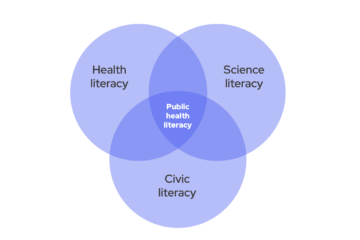
The public health field, on the other hand, is not considered technologically advanced. But in order to shape opinion, build trust, and engage with the communities they serve, public health professionals must adopt modern technologies and find ways to incorporate them into their strategies.
To explore the potential of virtual reality (VR) to advance public health, the de Beaumont Foundation, the American College of Preventive Medicine, the Prevention Institute, and Brightline Interactive have created a VR experience that highlights the role of policy in shaping community health. Attendees at the American Public Health Association’s annual meeting Nov. 2-6 have a chance to beta-test the VR experience at the de Beaumont Foundation’s booth (#811) in the Expo Hall. Using an Oculus Go headset, users can view scenes such as an urban community block, an apartment, a school cafeteria, and a residential neighborhood that show the differences in communities when policies are in place that affect social determinants of health, such as access to affordable housing, safe transportation options, and healthy food. An example of one of the scenes is below:

Scenes from “Health in All Communities: A Virtual Reality Experience” depicting a community block with and without policies that support housing, transportation, and food access.
What Are the Benefits of Virtual Reality?
Virtual reality is different from written text, photography, or video because it’s an immersive experience that allows users to interact in real time. That’s why it’s being used to train surgeons, simulate military experiences, treat anxiety and other conditions, and allow students to explore 3D environments and interact with each other.
In many sectors, VR is being used in powerful ways to educate and tell stories. For example, at the Mount Sinai Simulation HELPS Center, doctors are researching the potential impacts of VR-based simulation on reducing skill decay among clinicians providing Advanced Cardiac Life Support. In another instance, students and faculty from Shenandoah University developed a virtual reality video to make the history of civil rights sit-in protests come alive. Experiencing training or stories that are simultaneously physical, spatial, visual, and aural in nature leaves users wanting to know more and sparks curiosity among audiences. When people are experiencing VR, they are not just listening to the story — they are in the story.
Additionally, VR’s immersive storytelling is capable of changing attitudes, beliefs, and behaviors. If public health practitioners want people to look at public health concepts differently, they need to elicit strong emotions — and VR can do just that. According to research on narrative transportation theory, being immersed in media like movies makes viewers less likely to create counterarguments and they report emotional connections with the characters. Creating an immersive narrative in VR has the potential to make abstract concepts like the “social determinants of health” understandable, relevant, persuasive, and engaging.
What’s Next?
Virtual reality technology doesn’t have to break the bank. It’s possible to rent a camera and headset for under $200. Another option is the MERGE VR Headset (only $39.99) that uses a smartphone into the VR experience when the MERGE app is downloaded. This headset is used for education in schools, businesses, and libraries. If you have an LG or Google phone, Google Cardboard (a $25 headset) is an affordable option.
Many graphic designers are developing skills in designing for VR. You can hire an agency that specializes in VR graphics or an individual freelancer. You can also apply for a VR grant from VR for Impact, ClassVR, NIH, or partner with your local university.
At the de Beaumont Foundation, we’re still learning ourselves. We are grateful for the opportunity to partner with the American College of Preventive Medicine, the Prevention Institute, and Brightline Interactive to explore the potential uses of VR and develop this pilot project. We’d love to hear what you’re doing with virtual reality and other technology. Let us know if you have questions or if you’d like to share your own experiences with us.




